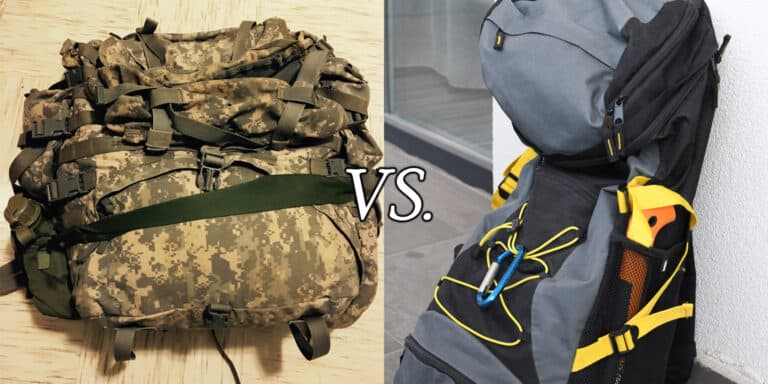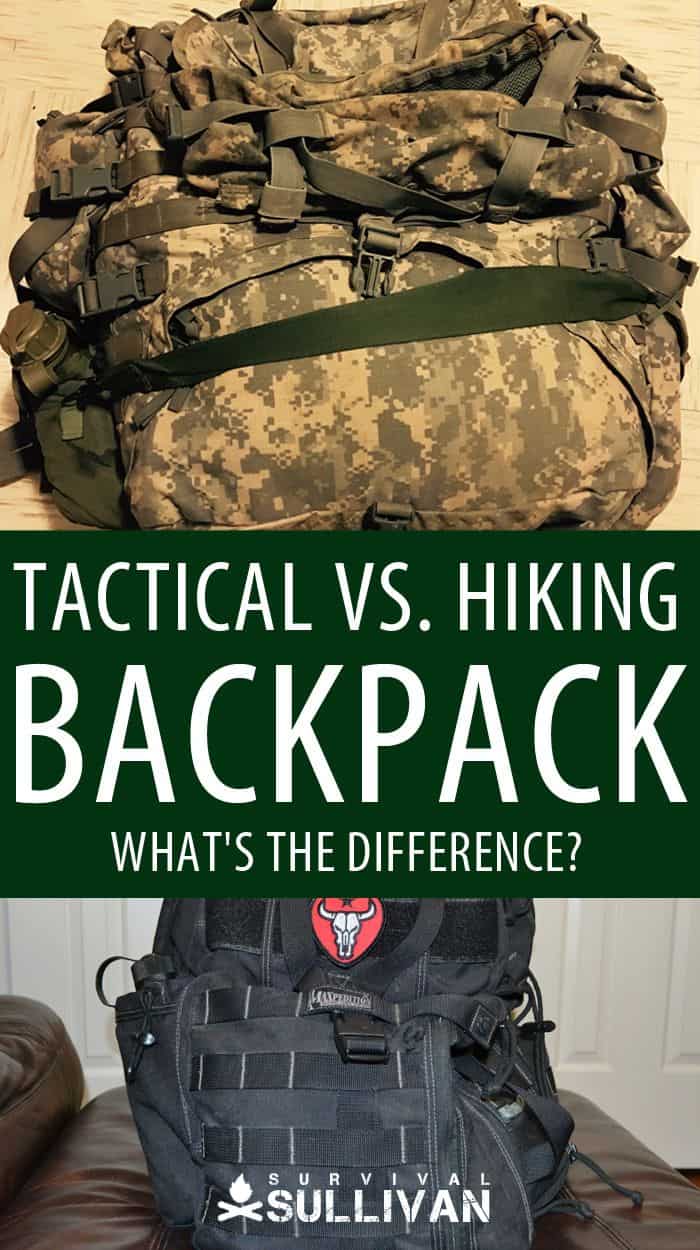There is a bewildering variety of backpacks on the market today, and considering that every prepper worth the name will have a bug-out bag packed and ready for any eventuality, choosing a backpack is a pretty big deal.

Compared to decades gone by, sometimes the distinction between various types of backpacks and their intended roles is not so clear.
Several cutting-edge, technical hiking and expedition backpacks look like something off of a science fiction movie set, and hulking, super-tough military rucksacks can hold everything plus the kitchen sink with room left over.
Many articles will refer to “tactical” backpacks or “hiking” backpacks, sometimes even using them interchangeably.
So, this begs the question: What is the difference between tactical and hiking backpacks?
Tactical backpacks emphasize durability, low observability, and expansion through storage capability. Hiking backpacks emphasize comfort, carrying capacity and light weight, typically in a variety of high visibility colors and patterns.
But, as mentioned, there is significant overlap between the two, and some entire brands of backpack have built their reputation on fusing the best characteristics of each.
In the remainder of this article we will look a little closer at the distinctions between hiking and tactical backpacks.
Durability
Perhaps the single biggest difference between hiking-specific and tactical use backpacks is their durability, and this durability is typically made possible by the use of heavier and more rugged materials.
Military backpacks are often made from 500d, or 1000d ballistic nylon, a heavy-duty material that can withstand a considerable amount of heat, abrasion and friction before failing.
Older, surplus military backpacks from eras gone by were made from heavy canvas or similar fabric blends.
Though these material options do lend military backpacks a ruggedness that is hard to match, it drastically increases the weight of an empty pack, and therefore the overall load.
Compared to military backpacks, most hiking and technical backpacks are made from increasingly advanced but paper-thin in flyweight materials that afforded excellent strength for their thickness.
If constructed properly, you won’t have to worry about these thin materials blowing out, but you should also not expect them to put up to the rigors of use that would be expected on a battlefield, or in a military theater.
Put another way, a tactical backpack can withstand more outright abuse than an equivalent hiking backpack, but it does so at the cost of increased weight.
Expansion Capability
Though we have seen the prevalence of MOLLE attachments and PALS webbing migrate through the rest of the backpack industry from the military packs that spawned it, tactical backpacks still rule the roost when it comes to expansion capability.
Most of these backpacks will have PALS webbing or other attachment slots on every available surface that is not already occupied by a strap, buckle or zipper.
This can be a nice perk for the prepper who wants to add a couple of purpose-specific pouches for special items or just easy access, but the temptation will always be there to add more and more storage to what is typically already a sizable backpack.
This further runs the risk of unbalancing the load carried by the pack.
Hiking-specific packs on the other hand will rarely have more than a single field, or perhaps two small fields of PALS webbing for expansion, though sometimes admin pouches or specialty tie-downs can be equipped on these packs for toting camera tripods, tent poles and other bulky items that will not fit in the main compartment.
A very few hiking specific packs utilize proprietary expansion systems that are not compatible with any other backpack.
Generally, when you choose a hiking backpack, the layout is what it is and you will not be able to modify it very much from its stock configuration.
Color
One of the most obvious differences between tactical and hiking packs is coloration. Tactical backpacks are invariably found in some low-observable color like black, dark gray, olive drab green, tan or one of innumerable camo patterns, from the general purpose to the incredibly environment specific.
When you are engaged in an activity where detection equals hostile fire directed your way, or just a mission failure, every piece of equipment must be bent towards reducing your visual profile, among other things.
Being spotted from a distance is quite literally the last thing you want to happen in that situation!
Generally, the reverse is true for hiking packs. Hiking packs can be found in all kinds of colors, and especially common are high-visibility colors that make the carrier easier to spot from a distance, with bright yellows, oranges and acid greens being popular (though some people who cannot abide these garish tones opt for charcoal gray, blue or other, more subdued colors and patterns).
When the biggest risk one will encounter on an expedition or hike is getting lost and then subsequently not being found, carrying anything that makes you more visible to your mates or to Rescuers makes perfect sense.
Before you get too wrapped up in color selection for any given pack, do keep in mind it is a simple thing to add a detachable cover or rainfly to a pack that can camouflage a brightly-colored pack or make a camouflage pack far more visible, depending.
Many of these covers are reversible so you are ready for all eventualities.
How To Choose The Right Pack For You
The gear that you choose should reflect the situation you’ll be using it in. Both tactical and hiking backpacks have their strong points. In most situations, you can get by using either choice.
Your decision will go beyond choosing how many pockets it has and how much padding will support you. Placement of certain features will become one of the most important factors.
Internal vs. External Frames
Both styles of packs can feature metal frames that provide extra support with heavy loads. It allows the wearer to haul heavy amounts of gear while distributing the weight more effectively than just wide, padded straps.
An externally framed backpack is easily spotted by the exposed frame components. These packs tend to have a box shape and are meant for travel on well-maintained pathways. Using these for bushwhacking would be awkward and difficult since the pack will catch on branches and other obstacles.
Internal-frame backpacks provide the same support but with a slimmer profile that hugs your body. If you’re going off the beaten path then this is a good choice since it holds the weight of your gear closer to your body. Internal frame packs improve your center of balance and lets you glide through the woods easier.
Hydration Requirements
Water bladders are commonplace in the backpacking world and they can be handy out in the wilderness. These bladders can hold many liters of water and provide easy access to your water source.
Additionally, a hydration bladder frees up space since you won’t have to carry around those pesky water bottles. Be aware of the size of your hydration pocket as it can sometimes take up some space from your main compartment. Most hydration bags have a slim profile but are as long as the pack itself.
Shoulder and Hip Straps
Some backpacks have several straps that perform a specific task. These straps are meant to help distribute the weight across your body, reducing fatigue and wear on the bag itself.
Waist belts are also called a hip belt or a sternum strap. It’s essentially a padded belt that clips snugly around your hips. It’s designed to transfer some of the weight to your hips and provide extra balance.
Padded shoulder straps help your shoulders handle the weight from the top. They are usually wide so as to not dig into your collarbone and are generally padded as well.
Additional Accessories
Attachment points, velcro, side compression straps, and MOLLE webbing are excellent examples of additional accessories that help protect the bag or let you carry more stuff.
If you have to work on the road then a padded laptop sleeve is always handy to have for slim electronics.
Hiking backpacks will gravitate towards features that help you on your outdoor adventures whereas tactical backpacks will focus more on maximizing what you can carry and making it easily accessible.
Frequently Asked Questions
MOLLE stands for Modular Lightweight Load-Carrying Equipment and is a system of webbing straps that can connect with additional storage accessories without compromising the functionality of the bag. You will often find this system on tactical backpacks.
The best tactical backpacks are meant to provide strategic access to things like firearms and emergency supplies while giving you the ability to expand the storage.
Many people believe they need a specific backpack for a certain activity. While this isn’t necessarily true, there are some advantages in having a pack made for certain scenarios. The best teacher is experience, and ultimately you won’t know until you try it.
Conclusion
There are quite a few differences between tactical and hiking backpacks. Tactical backpacks emphasize a low profile, extreme ruggedness, and the capability to expand the pack through the use of attachable pouches for any purpose.
Hiking backpacks emphasize low-weight, high capacity, and are often found in a variety of eye-catching colors, many of which are designed for maximum observability at long range.
Depending on your needs, one of these packs might serve you best, or you could do better by going with a hybrid backpack that combines elements from the two.


Tom Marlowe practically grew up with a gun in his hand, and has held all kinds of jobs in the gun industry: range safety, sales, instruction and consulting, Tom has the experience to help civilian shooters figure out what will work best for them.

Thanks a lot for the in depth explanation!